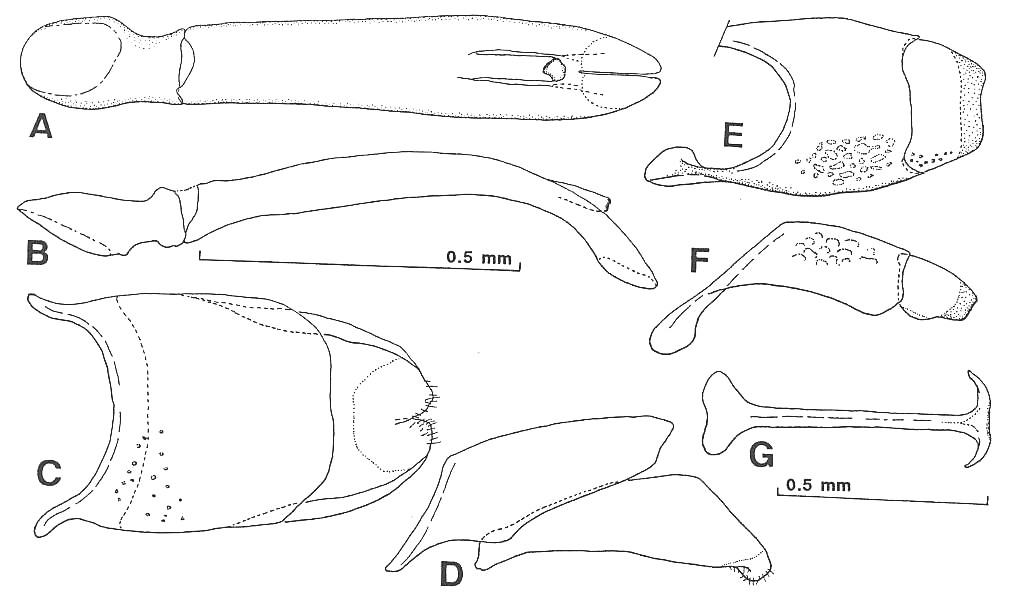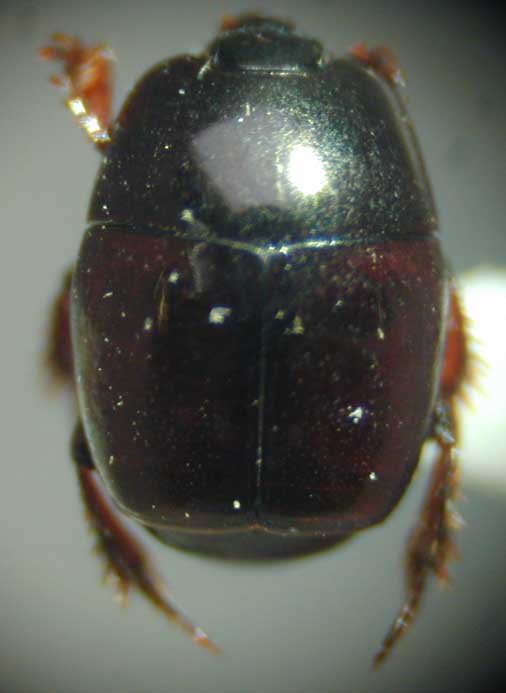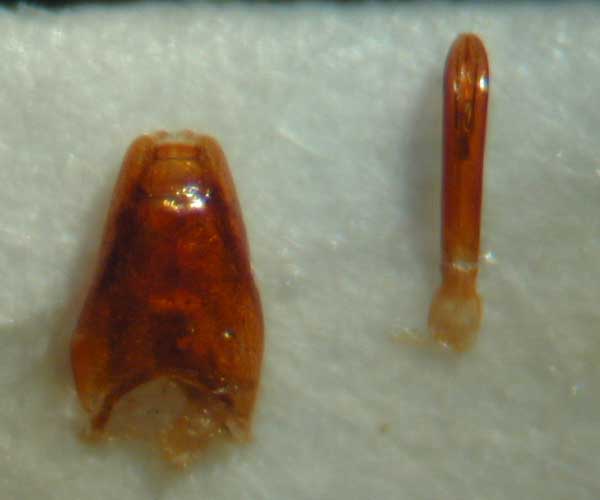
Saprinus varians Schmidt, 1890: 55 [Japan; China]; Lewis, 1910: 58; Desbordes, 1919: 416.
Hypocaccus varians: Reichardt, 1926b: 15; Reichardt, 1941: 323, 326.
Hypocaccus (Baeckmanniolus) varians: Kryzhanovskij and Reichardt, 1976: 229.
Hypocaccus (Baeckmanniolus) varians varians: Ohara, 1994, 258; ESK & KSAE, 1994, 136 [Korea].
Japanese name: Hamabe-emma-mushi.
Description. Body length, PPL, 2.45 - 4.19 mm (3.44 ± 0.10, n=20), PEL, 2.22 - 3.60 mm (3.11 ± 0.08, n=20). Width, 1.90 - 3.20 mm (2.56 ± 0.07, n=20). Biometric data are given in Table 52. Body oval and moderately convex. Cuticles very strongly shining and black or nearly so with strong bronzy, or brassy lustre; antennae dark rufopiceous with club rufotestaceous; legs dark reddish brown.
Frontal stria (Fig. 151C) carinate, complete and straight on each side. Supraorbital stria well impressed. Disk of front with only one ruga, sometimes with two or three short ones. Epistoma scabrose.
Pronotal sides (Fig. 151A) rather feebly arcuate and feebly convergent on basal four-fifths, thence strongly arcuate and convergent to apices. Apical angles round. Marginal stria carinate and complete. Disk smooth, rarely with several moderate punctures in anterior angle. Basal margin of pronotum with one row of moderate punctures, which become finer near the middle and on the lateral sixth.
Epipleura of elytra sparsely clothed with microscopic punctures and even. Marginal epipleural stria complete and finely impressed. Marginal elytral stria carinate, complete and densely punctate, its apical end extending along the posterior margin of elytron, and united with the apical end of sutural stria at medio-apical angle of elytron. External subhumeral stria absent. Internal subhumeral stria shortly present on median third. Oblique humeral stria present on basal third. First dorsal stria present on basal half and well impressed. Second dorsal stria a little longer than the 1st, and densely crenate apically. Third dorsal stria about as long as the 2nd, and densely crenate. Fourth dorsal stria shortly present on median area, composed of five or six punctures. Sutural stria present on apical two-thirds, finely impressed, its apical end united with the marginal elytral stria. Mediobasal area with a short arch consisting of the ends of 4th dorsal and sutural striae, sometimes the arch extending apically, rarely continued to the basal end of sutural stria. Surface of elytra smooth on basal half; on apical half moderately and sparsely punctate except on extreme apex (around apical stria), the punctures being separated by their own diameter to twice the dimeter.
Propygidium densely and coarsely punctate. Pygidium (Fig. 151D) densely and coarsely punctate on basal two-thirds, the apical third being sparsely punctate along margin and mid line, with two convex and impunctate areas on both sides.
Anterior margin of median portion of prosternum (Fig. 140B) obtuse-angulate. Preapical foveae distinctly present. Keel moderately compressed, its apex round. Descending lateral stria carinate and convergent to apex. Carinal striae present on basal half and convergent apically. Lateral sides of keel impunctate.
Anterior margin of mesosternum feebly emarginate, its marginal stria carinate and usually complete, sometimes interrupted at middle. Disk smooth. Meso-metasternal suture finely impressed, without a parallel crenate line. Intercoxal disk of metasternum smooth, sparsely clothed with microscopic punctures except for a transverse apical band of sparse and fine punctures. Lateral metasternal stria well impressed, carinate, extending obliquely and posteriorly, reaching near hind coxa. Lateral disk evenly and coarsely punctate, the punctures becoming sparser apically. Metepisternum densely covered with moderate punctures.
Intercoxal disk of 1st abdominal sternum completely striate on each side, and finely punctate along posterior margin.
Protibia with 7 spinules on outer margin.
Male genitalia as shown in Fig. 152.

Table 52. Biometeric data of Hypocaccus v. varians (Schmidt) and H. v. hatsune (Nakane).
-------------------------------------------------------------------------------------------------------------------------------------
v. varinaus v. hatsune
-------------------------------------------------------------------------------------------------------------------------------------
APW 0.72-1.21 (1.02±0.03) 20 0.62-0.98 (0.87±0.03) 13
PPW 1.67-2.71 (2.31±0.06) 20 1.54-2.26 (1.98±0.07) 13
PL 0.88-1.37 (1.12±0.03) 20 0.85-1.21 (1.06±0.03) 13
EL 1.41-2.22 (1.89±0.05) 20 1.18-1.93 (1.61±0.07) 13
EW 1.90-3.20 (2.56±0.07) 20 1.67-2.45 (2.14±0.08) 13
ProW 1.21-1.90 (1.53±0.04) 20 1.01-1.57 (1.27±0.05) 13
ProL 0.36-0.59 (0.46±0.01) 20 0.26-0.43 (0.36±0.01) 13
PyL 1.14-1.81 (1.48±0.04) 20 1.05-1.67 (1.32±0.05) 13
PTL 0.65-1.01 (0.88±0.02) 20 0.59-0.88 (0.77±0.03) 13
MSTL 0.62-1.05 (0.87±0.02) 20 0.56-0.88 (0.74±0.03) 13
MTTL 0.65-1.18 (1.01±0.03) 20 0.65-1.08 (0.90±0.03) 13
------------------------------------------------------------------------------------------------------------------------------------
Remarks. Hypocaccus varians resembles superficially H. sinae; however the former can easily be distinguished from the latter by the mesosternum without carinal line, the elytral sutural stria usually absent on the basal half and the apical half of the pygidium impunctate.
Hypocaccus varians is a very common species. It lives on snady beach, in various decaying animal matters, such as carrion of birds, dog, turtle and fish.
Specimens examined. 3 exs., Onbetsu, collected under carrion of dog, on shore.
[Hokkaidô] 10 exs., Nezaki-kaigan, Hakodate, 19/vii/1952, K. Honma leg. (NA); 6 exs., Hakodate, 19/vii/1954, T. Nakane leg. (NA); 25 exs., Ditto, 19/vii/1954, K. Sawada leg. (NA); 3 exs., Shiriuti, Oshima, 8/vii/1976, T. Kumata leg. (EIHU); 2 exs., Kojô-Hama, Shiraoi, 30/vii/1953, M. Ôtake leg. (NA); 1 ex., Zenibako, Otaru, 24/vi/1954, T. Kumata leg. (EIHU); 38 exs., Ditto, 23, 30/v, 8/vii/1977, 10/v/1978, 19/vi/1979, N. Nishikawa leg.; 31 exs., Ditto, 14/v, 30/viii/1985, M. Ôhara leg.; 1 ex., Ishikari-kakô, 19/ix/1987, M. Hinakura leg.; 6 exs., Ishikari, 1/vii/1976, M. Kiuchi leg.; 1 ex., Maruyama, Sapporo, 23/vi/1979, N. Nishikawa leg.; 2 exs., Toyotaki, Sapporo, 14/vi/1987, M. Ôhara leg.; 1 ex., Iwanai, 13/viii/1946, Y. Nishijima leg.; 1 ex., Daisetsu, 7/viii/1954, T. Nakane leg. (NA); 1 ex., Kitahama, Abashiri, 10/vii/1958, T. Nakane leg. (NA); 2 exs., Hakodate, 19/vii/1954, K. Sawada leg. (NA); 3 exs., Ditto, T. Nakane leg. (NA); 4 exs., Ditto, 19/viii/1952, K. Honma leg. (EIHU). <Okushiri Is.> 1Åä, Aonae, 28/vi/1986, Y. Kusui leg.
[Honshû] <Yamagata-ken> 1 ex., Fukura, 11/vi/1972, H. Takizawa leg. <Fukushima-ken> 1 ex., Nashidaira, Fukushima-shi, 3/vii/1988, K. Tazoe leg.; 11 exs., Fujima-kaigan, Iwaki, 25/vi/1988, K. Tazoe leg. <Chiba-ken> 130 exs., Ôami, 19/vi/1984, 20/v/1986, 1/iv/1987, M. Ôhara leg.; 5 exs, Shirako, 18/v/1984, M. Ôhara leg.; 1 ex., Katsuura, 3/viii/1963, M. Ishida leg.; 1 ex., Iwai, Bôsô-Hantô, 23/viii/1966, Y. Kusui leg.; 2 exs,. Narashino, 18/vi/1963, S. Kondo leg.; 1 ex., Cape Futtu, 2/vii/1961, H. Yamazaki leg. (NA); 4 exs., Ichinomiya, Kazusa, 6/vi/1936, T. Nakane leg. (NA). <Kanagawa-ken> 2 exs., Aburatsubo, 11/v/1959, S. Kondo leg.; 2 exs., Koshigoe, 3/viii/1944, Y. Kurosawa leg. (NA). <Niigata-ken> 1 ex., Niigata-shi, 5/v/1933, K. Baba leg. (NA). <Shizuoka-ken> 1 ex., Heda, Mihama-Misaki, Izu-Hantô, 7/vi/1974, M. Ishida leg. <Aichi-ken> 35 exs., Miya, Mikawa, 1-2/ix/1947, S. Ôsawa leg. (NA). <Wakayama-ken> 4 ex., Nachi, Kii, 19/vii/1946, 26, 29/iv/1947, S. Ôsawa leg. (NA); 1 ex., Ditto, 28/iii/1953, K. Sawada leg. (NA); 3 exs., Shingû, southern Kii, 10/vii/1946, S. Ôsawa leg. (NA); 1 ex., Minabe, sea shore, 2/vi/1966, M. Yoshida leg. (NA). <Ôsaka-fu> 1 ex., Takaishino-hama, 10/ix/1966, no collector's name. <Ishikawa-ken> 10 exs., Uchinada-sakyû, 31/viii/1968, H. Ebihara leg. (NA). <Hyôgo-ken> 1 ex., Hiraiso, 14/viii/1954, T. Shibata leg. (NA); 2 exs., Akashi, 8/v/1954, H. Ishida leg. (NA); 3 exs., Mikage-kaigan, 22/vii/1938, K. Sakaguchi leg. (NA). <Okayama-ken> 2 exs., Ushimado, Oku, 20/viii/1975, T. Aono leg. (NA). <Izu Isles.> 2 exs., Shikine-jima, 1941, K. Oyama leg. (NA).
[Shikoku] <Tokushima-ken> 1 ex., Kiki, Yuki-chô, 4/v/1986, S. Mano leg.; 2 exs., Anan, Kitanawaki-kaigan, 1/vi/1986, S. Mano leg.
[Kyûshû] <Fukuoka-ken> 2 exs., Satsuki-matsubara, 8/v/1983, S. Nakao leg. (NA); 5 exs., Ainoshima, 22/v/1983, S. Nakao leg. (NA). <Nagasaki-ken> 2 exs., Kuchinotsu, Shimabara, 20/ix/1977, S. Imasaka leg.; 3 exs., Nodahama, Kazusa-chô, 30/iii/1985, S. Imasaka leg.; 1 ex., Ditto, 5/iv/1977, S. Imasaka leg. <Kagoshima-ken> 26 exs., Chôsa, 14/vi/1983, 22/v/1984, M. Ôhara leg.; 24 exs., Fukiage, 29/vii/1984, M. Ôhara leg.; 1 ex., Sata-misaki, 29/v/1971, K. Tazoe leg. <Tsushima Is.> 8 exs., Kuroshima, 4/viii/1959, K. Tsukamoto leg. (NA).
[Nansei Isles.] <Tane-ga-shima Is.> 1Åä, 59 exs., Hamada, 31/vii/1984, Y. Harada leg. <Amami-Ôshima Is.> 69 exs., Akaogi, 2/vii/1984, M. Ôhara leg. <Tokuno-shima Is.> 2 exs., Kametsu, 24/iv/1954, T. Kumata leg. (EIHU). <Yoron Is.> 1 ex., 27/iii/1967, T. Matsumoto leg. <Ishigaki Is.> 1 ex., Botanical Garden, Banna, 12/vi/1974, H. Makihara leg.
Korea: Gangweon-do: Chungchong, Maniipo, near Taean, 8-9/vi/1982 (1 female [EHU], T. Fujisawa). Cheju-do: Hanrim, 10/x/1991 (1 ex., J.-C. Paik).
Japan: [Hokkaido] Proper: Okoppe-gawa-kako, Okoppe-cho (4 exs., 21/vi/1994, HOR), S. Hori; Saru-kaigan, Okoppe-chô (1 ex., 17/viii/1994, HOR), S. Hori; Shiranuka (19 exs., 25/v/1985; 3 exs., 31/v/1992), M. Ohara; Tomakomai-kaigan, Tomakomai (9 exs., 9/vi/1974), H. Onodera; Nanae-hama, Hakodate (1 ex., 20/v/1992), M. Ohara; Nr. Bashukuru-shitsugen, Onbetsu-cho (2 exs., 31/v/1992), A. Saitô; Shioya, Otaru (13 exs., 14/v/1994, SA), K. Sasaki; Kotan, Atsuta (2 exs., 18/vi/1995, SA), K. Sasaki; Rebunnka, Toyoura (2 exs., 22/v/1994, SA), K. Sasaki. Oshima-Oshima Is.: Yamase-domari (1 ex., 25/vi/1994, NIS), H. Nishijima; Torikarasu (3 exs., 23/vi/1994, NIS), H. Nishijima.
[Honshu] Aomori-ken: Moriyama, Iwasaki-mura (1 ex., 25/vii/1991, APM), A. Abe; (1 ex., 26/vii/1991, APM), S. Yamauchi; Kawajiri, Shichiri-nagahama, Ajigasawa (2 exs., 1/x/1992), M. Ohara. Chiba-ken: Kazusanomiya (2 exs., 7/v/1976; 2 exs., no date), S. Morita; Oami, Sanbu-gun (3 exs., 23/v/1994), M. Ohara; Katakai beach (8 exs., 16/vi/1974, CBM-ZI-53975-53982), H. Yamazaki; Ichinomiya sea side, Ichinomiya-machi (4 exs., 28/v/1973, CBM-Z-53928-29, -33; 10 exs., 8/viii/1973, CBM-Z-62457, -62460, -53926, -30-32, -34-5, -56-57), H. Yamazaki; Kimigahama, Chôshi-shi (1 ex., 26/iv/1971, CBM-ZI-62459), H. Yamazaki; Takeoka sea side, Futtu-shi (1 ex., 3/v/1971, CBM-ZI-62458), H. Yamazaki; River mouth of Kriyama river (2 exs., 16/vi/1974, CBM-Z-53971, -2), H. Yamazaki; Obitsugawakakou (2 exs., 16/vi/1987, CBM-Z-7115, -6), T. Itoh; Kazusaminato (14 exs., 10/vii/1968, CBM-Z-53944-46, -49-51, -58-65, ), H. Yamazaki; Funabashikaigan, Fuanbashi-shi (5 exs., 29, 30/viii/1990, CBM-Z-59922-24), T. Itoh; Kidohama, Hikari-chô (20 exs., 21/ix/1985, CBM-Z-61426, -28-46), T. Itoh; Chikura (1 ex., 22/viii/1974, CBM-Z-53952), H. Yamazaki; Katsuura, Katsuura-machi (1 ex., 11/viii/1973, CBM-Z-53966), H. Yamazaki; Cape Daito, Misaki-chô (1 ex., 20/vi/1971, CBM-Z-53953), H. Yamazaki; Okiyama sea side, Kisarazu-shi (2 exs., 15/vii/1973, CBM-Z-53954-5), H. Yamazaki; Takeoka sea side, Futtsu-shi (3 exs., 3/v/1971, CBM-Z-53938-40), H. Yamazaki; Toyomi (3 exs., 8/iv/1971, CBM-Z-53943, -47-8), H. Yamazaki; Onjuku-machi (6 exs., 23/ix/1986, CBM-Z-61447-53), T. Itoh; Kimigahama, Chôshi-shi (1 ex., 26/iv/1971, CBM-Z-53942), H. Yamazaki. Kanagawa-ken: Shichiri-ga-hama, Kamakura (4 exs., 10/x; 2 exs., 24/viii/1989), K. Kawada; Tateishi, near Akiya, Yokosuka (1 ex., 25/vi/1990), K. Akiyama; Ôiso (3 exs., 14/iii/1996), K. Kasagi; Isshiki-kaigan, Hayama (29 exs., 23/iii/1963, YCM), T. Hamaguchi; Shinjyuku-hama, Zushi (1 ex., 16/ix/1962, YCM), T. Hamaguchi; Nobi-kaigan, Yokosuka (1 ex., 30/vi/1963, YCM), T. Hamaguchi; Sarushima, Yokosuka (2 exs., 13/vi/1977, YCM), Y. Kusui. Aichi-ken: Hosoya, Omotehama, Toyohashi (2 exs., 21/v; 1 ex., 24/vi/1990), M. Hasegawa (Hasegawa & Kanie, 1992). Wakayama-ken: Kada (1 ex., 5/vi/1992), T. Itoh. Ishikawa-ken: Kanaiwa, Kanazawa (4 exs., 27/vii/1991), K. Nakata. Hyogo-ken: Mikage-machi, seashore, Kobe (2 exs., 22/vii/1938), K. Kurosa; Takasago (1 ex., 3/iv/1937), K. Kurosa; Tomyo, Mikage-machi, near Kobe, Mikage-tsuka-machi (now, Higashi-nada-ku) (1 ex., 3/viii/1938), K. Kurosa.
[Shikoku] Tokushima-ken: Mouth of Yoshino riv., Tokushima (1 ex., 14/vii/1996), T. Itoh.
[Kyushu] Fukuoka-ken: Nishinoura (1 ex., 29/iv/1994 ), K. Shima.
[Nansei Isles] Kume-jima: (17 exs., 5/iv/1993), D. Asaka.

Hypocaccus (Baeckmanniolus) varians hatsune (Nakane, 1977)
Baeckmanniolus varians hatsune Nakane, 1977: 148, 157 [Hatusne-ura, Chichijima, Ogasawara].
Japanese name: Ogasawara-hamabe-emma-mushi.
Original description. "Very closely allied to the nominate form from the main islands of Japan, but the body is generally smaller (2.4 - 3.5 mm in length). Punctures on both sides of anterior part of pronotum are very feebly impressed and frequently almost disappeared, and those on apical half of elytra are usually finer than in the nominate form. Elytra more or less paler in color than pronotum, at least dark reddish brown on both sides of prothorax usually somewhat reddish. Male genitalia smaller than in the typical form and the shape of apex of hypopygidium somewhat different. "
Additional description. (Ohara, 1994).
Body length, PPL, 2.45 - 3.83 mm (3.06 ± 0.12, n=13), PEL, 1.99 - 3.20 mm (2.76 ± 0.11, n=13). Width, 1.67 - 2.45 mm (2.14 ± 0.08, n=13). Biometric data are given in Table 52. Punctation of pygidium represented only on basal third to half.
Specimens examined. Holotype, Hatsune-ura, Chichi-jima, Bonin Is. (Ogasawara Is.) 5/vi/1975, K. Ichikawa leg. (NSMT); Paratypes, 13 exs., Ditto, (NA); 31 exs., Ditto, (NSMT).
Distribution. Japan (Ogasawara Isles.).


Hypocaccus varians hatsune: Holotype deposited in Natural Science Museum,
Tokyo.